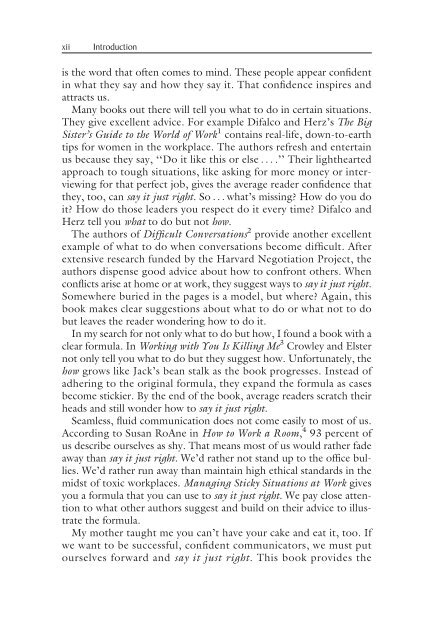Managing Sticky Situations at Work
Managing Sticky Situations at Work
Managing Sticky Situations at Work
Create successful ePaper yourself
Turn your PDF publications into a flip-book with our unique Google optimized e-Paper software.
xiiIntroductionis the word th<strong>at</strong> often comes to mind. These people appear confidentin wh<strong>at</strong> they say and how they say it. Th<strong>at</strong> confidence inspires and<strong>at</strong>tracts us.Many books out there will tell you wh<strong>at</strong> to do in certain situ<strong>at</strong>ions.They give excellent advice. For example Difalco and Herz’s The BigSister’s Guide to the World of <strong>Work</strong> 1 contains real-life, down-to-earthtips for women in the workplace. The authors refresh and entertainus because they say, ‘‘Do it like this or else ....’’ Their lightheartedapproach to tough situ<strong>at</strong>ions, like asking for more money or interviewingfor th<strong>at</strong> perfect job, gives the average reader confidence th<strong>at</strong>they, too, can say it just right. So...wh<strong>at</strong>’s missing? How do you doit? How do those leaders you respect do it every time? Difalco andHerz tell you wh<strong>at</strong> to do but not how.The authors of Difficult Convers<strong>at</strong>ions 2 provide another excellentexample of wh<strong>at</strong> to do when convers<strong>at</strong>ions become difficult. Afterextensive research funded by the Harvard Negoti<strong>at</strong>ion Project, theauthors dispense good advice about how to confront others. Whenconflicts arise <strong>at</strong> home or <strong>at</strong> work, they suggest ways to say it just right.Somewhere buried in the pages is a model, but where? Again, thisbook makes clear suggestions about wh<strong>at</strong> to do or wh<strong>at</strong> not to dobut leaves the reader wondering how to do it.In my search for not only wh<strong>at</strong> to do but how, I found a book with aclear formula. In <strong>Work</strong>ing with You Is Killing Me 3 Crowley and Elsternot only tell you wh<strong>at</strong> to do but they suggest how. Unfortun<strong>at</strong>ely, thehow grows like Jack’s bean stalk as the book progresses. Instead ofadhering to the original formula, they expand the formula as casesbecome stickier. By the end of the book, average readers scr<strong>at</strong>ch theirheads and still wonder how to say it just right.Seamless, fluid communic<strong>at</strong>ion does not come easily to most of us.According to Susan RoAne in How to <strong>Work</strong> a Room, 4 93 percent ofus describe ourselves as shy. Th<strong>at</strong> means most of us would r<strong>at</strong>her fadeaway than say it just right. We’d r<strong>at</strong>her not stand up to the office bullies.We’d r<strong>at</strong>her run away than maintain high ethical standards in themidst of toxic workplaces. <strong>Managing</strong> <strong>Sticky</strong> <strong>Situ<strong>at</strong>ions</strong> <strong>at</strong> <strong>Work</strong> givesyou a formula th<strong>at</strong> you can use to say it just right. We pay close <strong>at</strong>tentionto wh<strong>at</strong> other authors suggest and build on their advice to illustr<strong>at</strong>ethe formula.My mother taught me you can’t have your cake and e<strong>at</strong> it, too. Ifwe want to be successful, confident communic<strong>at</strong>ors, we must putourselves forward and sayitjustright. This book provides the















